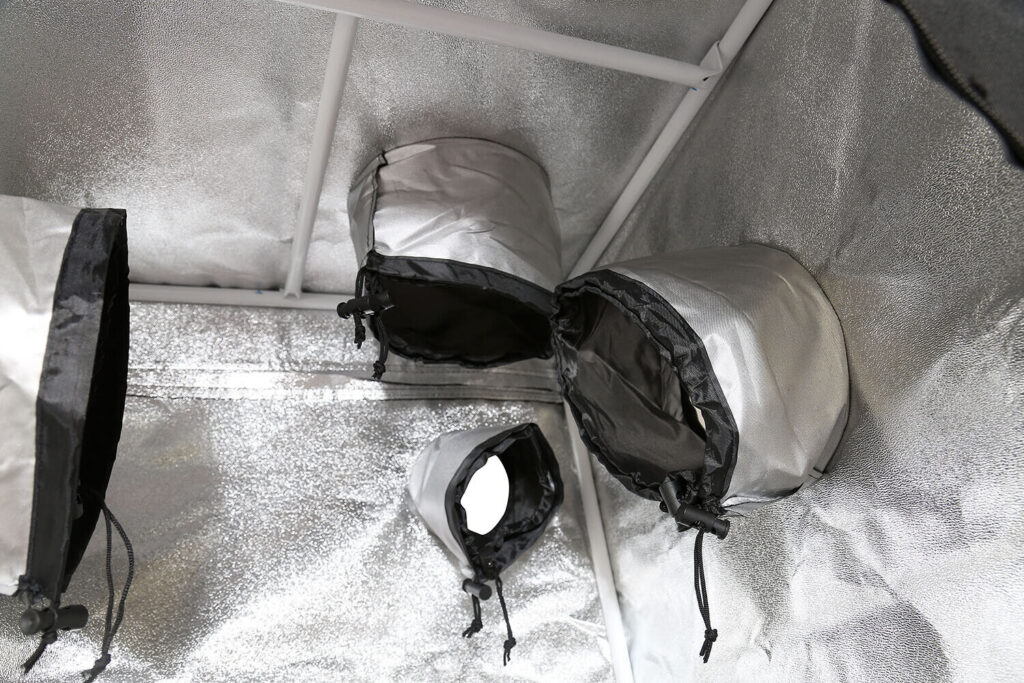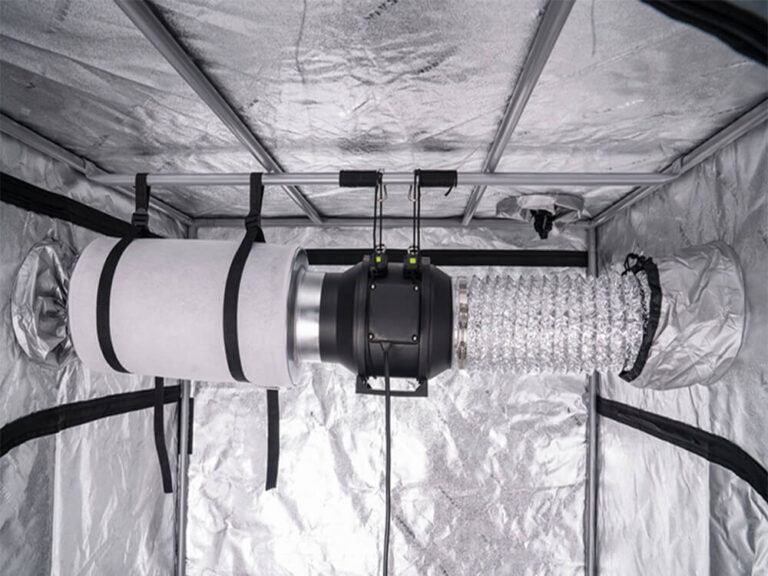Grow tents, designed for indoor plant cultivation, aim to create enclosed environments with reflective interiors, ventilation systems, and odor control features. They assist in containing plant odors, yet may not entirely eliminate strong smells. Effective odor containment depends on factors such as ventilation quality, carbon filters, and air circulation within the tent. Carbon filters, particularly, are crucial for trapping and neutralizing odors as air passes through them. Ensuring a well-sealed tent with sturdy zippers and quality materials helps prevent air leakage and controls the spread of smells.
Additionally, plant growth stages impact odor levels, with flowering stages emitting stronger smells than vegetative phases. To enhance odor control, implementing additional measures like exhaust fans, maintaining cleanliness, and regular equipment checks is advisable for minimizing lingering odors and maximizing containment within grow tents.
What impacts odor containment in grow tents?

By paying attention to these factors and ensuring a holistic approach to odor containment, growers can effectively manage and minimize the spread of smells from their grow tents.
Ventilation systems
Importance of proper ventilation
Proper ventilation is crucial in a grow tent to maintain a healthy environment for plants and manage odors effectively. It involves the exchange of air within the tent, allowing fresh air to enter and stale air to exit. Adequate ventilation helps regulate temperature, humidity, and oxygen levels, creating an optimal growth environment for plants.
Insufficient ventilation can lead to the accumulation of stagnant air, increased moisture levels, and the concentration of odors, which might affect plant health and create a pungent smell.
Role of carbon filters in odor reduction
Carbon filters play a pivotal role in reducing and eliminating odors in grow tents. These filters contain activated carbon, which effectively absorbs and traps odor-causing molecules as air passes through them. The activated carbon possesses a highly porous surface that chemically binds with odor compounds, neutralizing them and preventing them from escaping the filter.
When integrated into the ventilation system, carbon filters significantly enhance odor control by capturing and purifying the air before it is released back into the grow tent or expelled outside.
Air circulation within the tent
Impact on distributing filtered air
Efficient air circulation ensures the proper distribution of filtered air throughout the grow tent. It helps evenly disperse the purified air, maintaining consistent temperature and humidity levels across the entire space.
Properly circulated air ensures that the benefits of the carbon filters, such as odor reduction, are spread uniformly, reducing the likelihood of localized areas where odors might accumulate.
Preventing localized odor buildup
Adequate air circulation plays a critical role in preventing localized odor buildup within the grow tent. Stagnant air pockets or inadequate airflow can lead to the accumulation of odors in specific areas. This can result in uneven distribution of filtered air, creating pockets where odors remain concentrated.
To prevent this, proper ventilation systems and strategically placed fans help circulate air effectively, reducing the chances of odor pockets and ensuring a more consistent and controlled environment for plant growth while minimizing unwanted smells.
How do components affect odor control in grow tents?
Components within a grow tent play crucial roles in controlling odors. Various components contribute to the overall effectiveness of odor control.
Quality of the grow tent
Importance of well-sealed seams
Well-sealed seams in a grow tent are essential for effective odor containment. Seams are the points where different parts of the tent fabric are joined together. If these seams are not properly sealed, they can allow air to escape or enter the tent, potentially carrying odors with them.
Quality grow tents often feature reinforced and sealed seams to prevent air leakage. This not only helps in controlling odors but also aids in maintaining the desired environmental conditions inside the tent, such as temperature and humidity.
Significance of sturdy zippers
Zippers are critical components of a grow tent that facilitate easy access and sealing. Sturdy zippers ensure a tight closure, preventing air leaks that could lead to the escape of odors. When zippers are durable and properly functioning, they contribute to maintaining the integrity of the tent’s enclosure.
High-quality grow tents use robust zippers designed to withstand frequent opening and closing without compromising the seal, thus assisting in effective odor containment.
Relationship between materials used and air leakage prevention
The choice of materials in constructing a grow tent directly impacts its ability to prevent air leakage and control odors. Quality tents utilize materials that are not only durable but also possess properties that minimize air permeability. Fabrics with higher density and thickness are often preferred as they offer better resistance to air leakage.
Additionally, specialized materials with inherent properties for odor containment, such as those coated with substances to prevent the escape of smells, are sometimes used. The materials used in the construction of grow tents are selected to create a barrier that effectively contains odors within the tent, contributing significantly to odor control and overall environmental management for indoor plant cultivation.
What influences plant odors in different growth stages?

The odors emitted by plants can vary significantly throughout different growth stages due to changes in their physiological processes, chemical composition, and developmental stages.
Odor during flowering stages
The flowering stage is when plants tend to emit the strongest and most distinct odors. This phase, characterized by the development of flowers or buds, is crucial for reproduction in many plant species. During flowering, plants produce essential oils, terpenes, and other volatile compounds that contribute to their distinct aromas. These compounds are often more pronounced and concentrated in flowering plants, especially in certain species such as cannabis.
The potent fragrances released during this stage serve various purposes in nature, including attracting pollinators. However, for indoor cultivation in grow tents, these odors can be particularly intense and challenging to contain without proper odor control measures like carbon filters.
Comparison with vegetative stages
In contrast to the flowering stage, plants in the vegetative phase generally produce fewer strong odors. The vegetative stage is characterized by rapid growth, where plants focus on developing foliage, stems, and roots. During this phase, while some plants might still emit slight odors, they are typically milder compared to the flowering phase. The reduced intensity of odors in the vegetative stage is mainly because plants are not actively producing flowers or reproductive structures that release high concentrations of aromatic compounds.
As a result, controlling and containing odors in grow tents might be comparatively easier during vegetative growth stages than during flowering stages, requiring less stringent odor management techniques. However, maintaining consistent odor control measures throughout the plant’s life cycle is advisable to manage any potential smells effectively.
FAQ’s
Is a grow tent better than a room?
Grow tents offer controlled environments for cultivating plants, providing more manageable conditions for temperature, humidity, and light compared to regular rooms, making them advantageous for indoor gardening.
Do grow tents eliminate smell?
Grow tents equipped with proper ventilation systems, including carbon filters, can significantly reduce and control the smell emitted by plants, but complete elimination may vary based on factors like setup, filters used, and plant type.
Is it safe to sleep in the same room as a grow tent?
While technically possible, it might not be ideal due to potential concerns about increased humidity, heat, or plant-related odors that could affect sleep quality or respiratory health.
Do I need ventilation in my grow tent?
Yes, ventilation is crucial in a grow tent to manage temperature, humidity, and air circulation. It aids in controlling odors and providing plants with fresh CO2 for photosynthesis.
Should you put a fan in a grow tent?
Absolutely, fans aid in maintaining proper airflow, preventing stagnant air pockets, distributing heat evenly, strengthening plant stems, and reducing the risk of mold or mildew.
Do plants grow faster in a grow tent?
Generally, yes. Grow tents offer controlled environments where factors like light, temperature, and humidity can be optimized, potentially leading to faster and healthier plant growth compared to less controlled spaces like regular rooms.
Final Words
In summary, grow tents help plants grow indoors, but odors can be a challenge. Things like fans, filters, and good airflow help control smells. Strong zippers and tight seams stop smells from getting out. The type of materials used in tents also stops air from leaking. When plants are making flowers, they smell stronger than when they’re just growing leaves.
It’s important to use fans and keep things clean to control smells. Even with growing tents, some smells might stick around, so it’s essential to work hard to manage them for a nicer-smelling place to grow plants inside.

